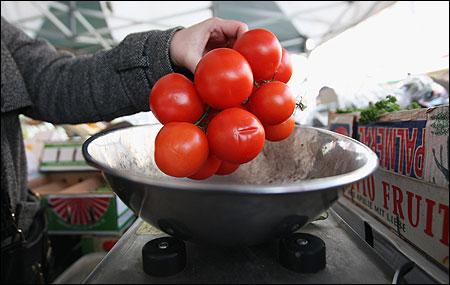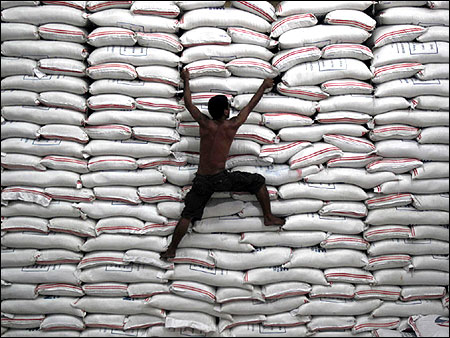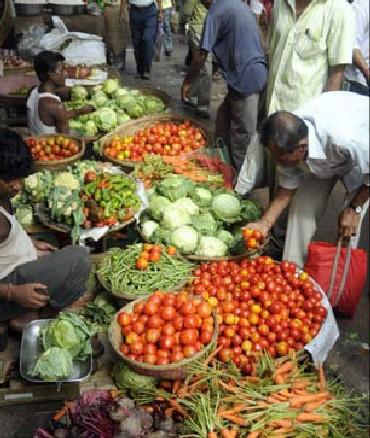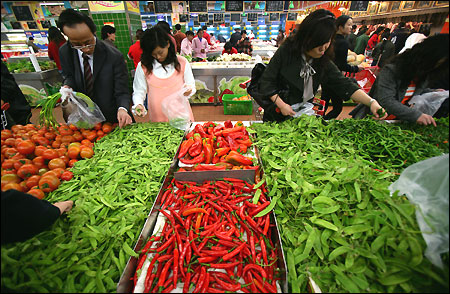 | « Back to article | Print this article |
Food inflation down to 8%; FM upbeat
The rate of price rise in non-food primary articles has fallen sharply during the past couple of months, from over 8 per cent to nearly 2 per cent in the week ended November 19.
Fuel and power inflation stood at 15.53 per cent during the week under review, compared to 15.49 per cent in the previous week.
The decline in the rate of price rise in food items is likely to bring some relief to the government and the Reserve Bank of India, which have been facing flak from all quarters for persistently high prices.
Pranab expects inflation to moderate to 6-7% by March: Encouraged by a steep fall in food inflation to 8 per cent, Finance Minister Pranab Mukherjee said on Thursday the overall rate of price rise will moderate to around 6-7 per cent by March, 2012.
"If this trend continues, perhaps we may have the year-end inflation at around 6-7 per cent," Mukherjee told reporters in New Delhi.
The decline in the rate of price rise in food items is likely to provide some relief to the government and the Reserve Bank of India, which have been facing flak from all quarters for persistently high prices.
Headline inflation has been above the 9 per cent-mark since December, 2010. It stood at 9.73 per cent in October this year.
In its second quarterly review of the monetary policy last month, RBI said it expects inflation to remain elevated till December on account of the demand-supply mismatch before moderating to 7 per cent by March, 2012.
Click NEXT to read further. . .
Food inflation down to 8%; FM upbeat
It also comes as a silver lining at a time when economic growth fell to 6.9 per cent in the second quarter, the lowest in over two years.
The eight key infrastructure industries witnessed dismal growth of 0.1 per cent in October, the lowest in the past five years.
The government had said steps were being taken to remove supply bottlenecks and expected prices to ease from December.
Headline inflation, which also factors in manufactured items, has been above the 9 per cent-mark since December, 2010.
Click NEXT to read further. . .
Food inflation down to 8%; FM upbeat
It stood at 9.73 per cent in October this year.
The RBI has hiked interest rates 13 times since March, 2010, to tame demand and curb inflation.
In its second quarterly review of the monetary policy last month, the central bank had said it expected inflation to remain elevated till December on account of the demand-supply mismatch, before moderating to 7 per cent by March, 2012.
The rate of price rise in non-food primary articles has fallen sharply during the past couple of months, from over 8 per cent to nearly 2 per cent in the week ended November 19.
Click NEXT to read further. . .
Food inflation down to 8%; FM upbeat
Fuel and power inflation stood at 15.53 per cent during the week under review, compared to 15.49 per cent in the previous week.
The decline in the rate of price rise in food items is likely to bring some relief to the government and the Reserve Bank, which have been facing flak from all quarters for persistently high prices.
It also comes as a silver lining at a time when economic growth fell to 6.9 per cent in the second quarter, the lowest in over two years.
Click NEXT to read further. . .
Food inflation down to 8%; FM upbeat
The eight key infrastructure industries witnessed dismal growth of 0.1 per cent in October, the lowest in the past five years.
The government had said steps were being taken to remove supply bottlenecks and expected prices to ease from December.
Click NEXT to read further. . .
Food inflation down to 8%; FM upbeat
Headline inflation, which also factors in manufactured items, has been above the 9 per cent-mark since December, 2010.
It stood at 9.73 per cent in October this year.
The RBI has hiked interest rates 13 times since March, 2010, to tame demand and curb inflation.
In its second quarterly review of the monetary policy last month, the central bank had said it expected inflation to remain elevated till December on account of the demand-supply mismatch, before moderating to 7 per cent by March, 2012.





